Roger Crowley's Blog, page 6
December 12, 2013
The shop signs of Valletta
My recent trip to Malta gave me the chance to explore Valletta again. I love the long straight vistas of the streets laid out by the knights of St John on a visionary grid pattern in the sixteenth century.
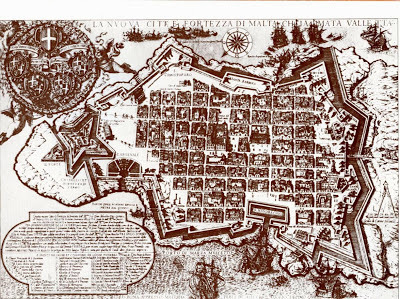
They ride the rise and fall of the land in severe straight lines, shaded from the sun, overhung with loggias and balconies. There’s a sense of expectation in the way the eye is led away towards the distant blue line of Mediterranean sea where the peninsula ends.
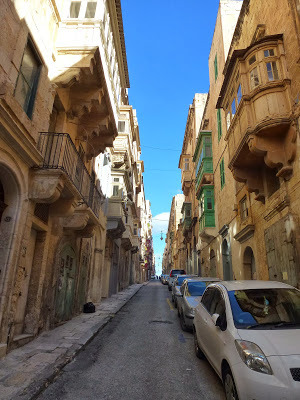 What really fascinated me was the old fashioned signage on shops and hotels – like being carried back into the sign writing of sixty or seventy years ago. A dusty memory of the British empire interspersed with Catholic shrines on street corners and small votive plaques above doorways. Here's a few of them:
What really fascinated me was the old fashioned signage on shops and hotels – like being carried back into the sign writing of sixty or seventy years ago. A dusty memory of the British empire interspersed with Catholic shrines on street corners and small votive plaques above doorways. Here's a few of them:




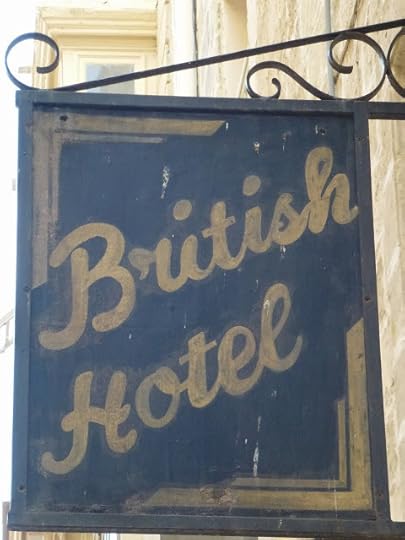
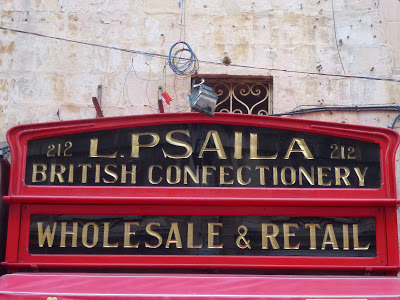
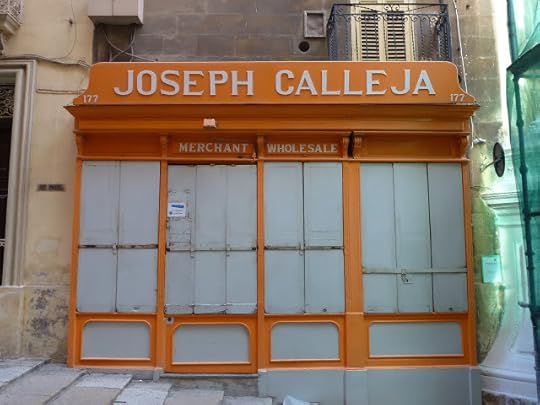
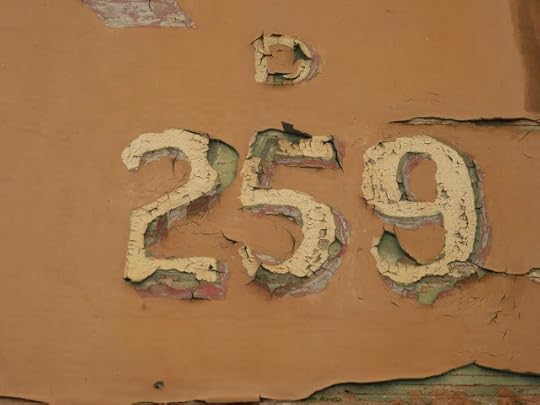

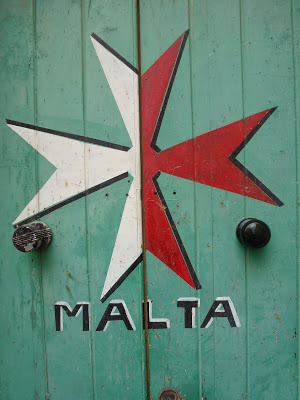
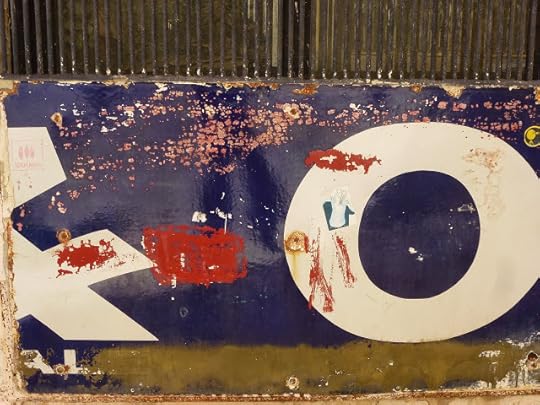
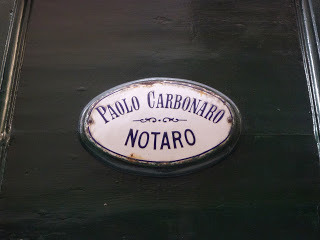
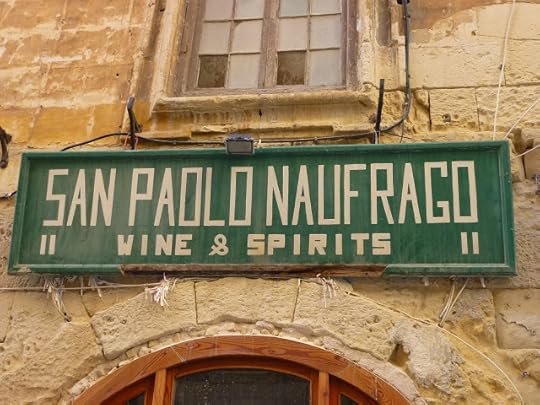
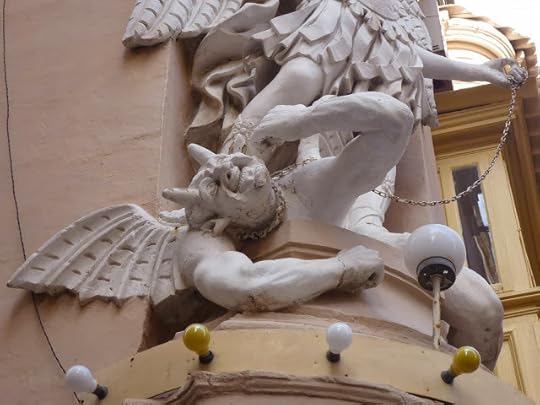


They ride the rise and fall of the land in severe straight lines, shaded from the sun, overhung with loggias and balconies. There’s a sense of expectation in the way the eye is led away towards the distant blue line of Mediterranean sea where the peninsula ends.
 What really fascinated me was the old fashioned signage on shops and hotels – like being carried back into the sign writing of sixty or seventy years ago. A dusty memory of the British empire interspersed with Catholic shrines on street corners and small votive plaques above doorways. Here's a few of them:
What really fascinated me was the old fashioned signage on shops and hotels – like being carried back into the sign writing of sixty or seventy years ago. A dusty memory of the British empire interspersed with Catholic shrines on street corners and small votive plaques above doorways. Here's a few of them:















Published on December 12, 2013 07:33
December 5, 2013
'A person who is afraid'
I’ve just returned from nine days on a ship, talking about the history of Malta and Sicily – a welcome break from the shortening days of an English winter (which have a charm all of their own). We departed from Palermo. The airport there is now called ‘The Falcone and Borsellino airport’ in honour of two anti-mafia judges.
The mafia’s origins lie deep within the sadly dysfunctional history of this beautiful and once wealthy island. Centuries, millennia of plunder by outsiders have stripped Sicilyand plunged it into deepening cycles of under-development and distrust of authority. Deprived of a sense of civic unity, the mafia inserted itself as a parasitic intermediary between downtrodden peasants and their rulers. It profited from the chaos following the Second World War, but it was the arrival of heroine in the seventies that accelerated the viciousness of mafia activities – and its ability to corrupt the core institutions of the Italian state. The body count started to pile up – judges, lawyers, communists, politicians, priests – killed in what has become known as the era of the ‘Illustrious Corpses’.
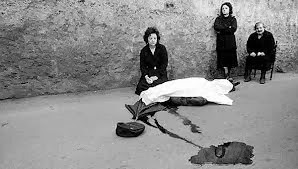
 General dalla Chiesa
General dalla ChiesaThere’s evidence that Giulio Andreotti, the most successful politician in post-war Italy was complicit in mafia dealing. Tried, he escaped conviction through legal loopholes. (There’s a curious circularity to Sicilian history. Two thousand years earlier, Cicero prepared a similar court case again the Roman governor of Sicily, Gaius Verres, for extortion, torture and murder. Verres slipped away into exile to avoid the conviction.)
General Alberto dalla Chiesa, a soldier with a track record of success against the Red Brigade, was gunned down with his wife in the street in 1982 – a death in which Andreotti was held to be complicit. Many people just disappeared – killed, in a sinister euphemism, by ‘The White Shotgun’. Young men from the slums of Palermo, strung out on heroine, were easily recruited into the lower echelons to conduct drive-by shootings and garottings. The profits from heroine were huge. By 1982, the Sicilian mafia were said to control 80% of the heroine trade in the north east of the USA, remitting over a billion dollars a year to Sicily.
 Riina 'the Beast'The Corleone clan emerged as the leading faction. Led by the incredibly violent, Salvatore ‘Toto’ Riina, ‘the Beast’, responsible for some 800 deaths, he broke the pact between competing clans and ruthlessly started to wipe out mafia rivals. But Riina’s transgressions increased the possibility that one day a vengeful rival would talk to the police.
Riina 'the Beast'The Corleone clan emerged as the leading faction. Led by the incredibly violent, Salvatore ‘Toto’ Riina, ‘the Beast’, responsible for some 800 deaths, he broke the pact between competing clans and ruthlessly started to wipe out mafia rivals. But Riina’s transgressions increased the possibility that one day a vengeful rival would talk to the police.Into this arena stepped two determined and patriotic anti-mafia magistrates, Giovanni Falcone and Paolo Borsellino, Palermo-born childhood friends who understood the mafia mentality. The breakthrough came with the arrest of a Mafiosi in Brazil, Tommaso Buschetta, in 1982. Bruschetta, who had lost many allies to the Corleone clan, was prepared to talk.
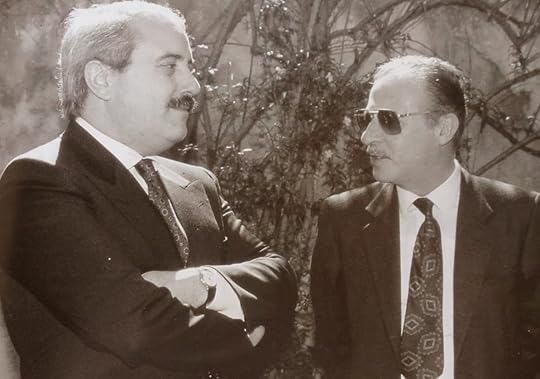 Giovanni Falcone and Paolo Borsellino
Giovanni Falcone and Paolo Borsellino
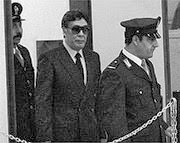 Buscetta at the trials After years of careful preparation, and the construction of a bomb proof court house adjacent to the prison, the so called Maxi-trials of 1986-1987 based on Buschetta’s evidence resulted in 19 life sentences and 338 other sentences totalling 2065 years. Falcone and Borsollino had torn a hole in the structure of the mafia. Furious at their failure to reverse the verdicts – a habitual procedure – Riina’s clan killed the political stooge, Salvatore Lima, who had promised to fix it. Then they turned on the magistrates.
Buscetta at the trials After years of careful preparation, and the construction of a bomb proof court house adjacent to the prison, the so called Maxi-trials of 1986-1987 based on Buschetta’s evidence resulted in 19 life sentences and 338 other sentences totalling 2065 years. Falcone and Borsollino had torn a hole in the structure of the mafia. Furious at their failure to reverse the verdicts – a habitual procedure – Riina’s clan killed the political stooge, Salvatore Lima, who had promised to fix it. Then they turned on the magistrates.Falcone and Borsellino were realistic enough to understand that their lives might not be long. On 23 May 1992 Falcone and his wife were killed by a massive car bomb as they drove from the airport.

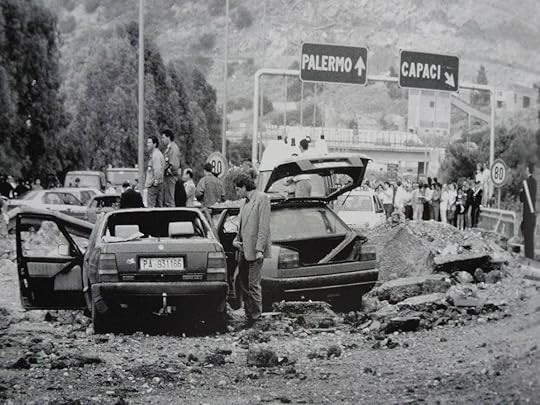 23 May 1992 57 days later Borsellino was killed in Palermo by a similar bomb:
23 May 1992 57 days later Borsellino was killed in Palermo by a similar bomb:
These spectacular deaths however swept the Sicilian people into a wave of protest and civic patriotism. They came out onto the streets and threw coins at mafia funerals as a sign of mocking disgust. Women were particularly prominent in a new determination to change the mentality of Sicilian people. The will to fight back had gained a hold over the imaginations of citizens.
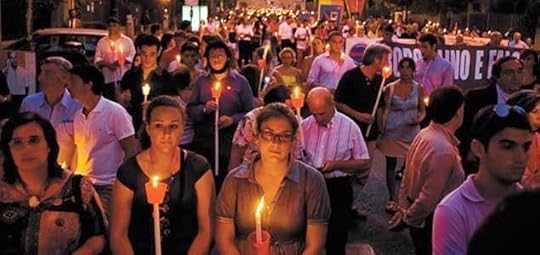 "It was years since I’d seen the faces of honest and brave Italians. I saw crowds of young people, as if they’d woken from a deep sleep.” Giorgio Bocca, JournalistThe car bombings also forced the state to be resolute. When Riina was bundled out of car in Palermo in 1993 by masked men he was relieved to discover they were policeman. (If anyone had wanted to arrest Riina earlier he wouldn’t have been hard to find – his children were enrolled in school in Corleone and he frequently used the local hospital.) In 1996 they captured the particularly detested hit man, Giovanni Brusca:
"It was years since I’d seen the faces of honest and brave Italians. I saw crowds of young people, as if they’d woken from a deep sleep.” Giorgio Bocca, JournalistThe car bombings also forced the state to be resolute. When Riina was bundled out of car in Palermo in 1993 by masked men he was relieved to discover they were policeman. (If anyone had wanted to arrest Riina earlier he wouldn’t have been hard to find – his children were enrolled in school in Corleone and he frequently used the local hospital.) In 1996 they captured the particularly detested hit man, Giovanni Brusca:
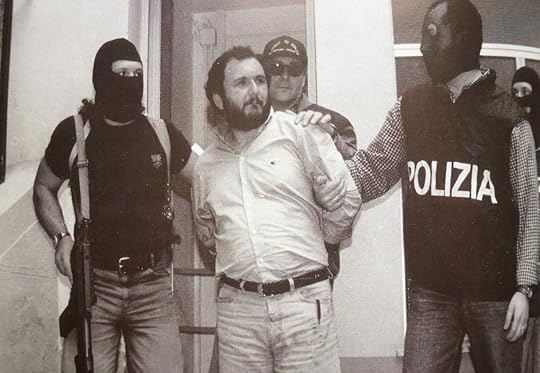 Bernard Provanzano, nicknamed ‘the Tractor’, who took over the Corleone clan, was snatched in 2006. All these men are held in secure solitary confinement – to stop them running their operations from behind bars – or from being murdered by rivals. (The poisoned espresso has seen the death of at least one mafia boss in his cell.) So tightly have they been isolated that human rights groups have protested against their treatment.
Bernard Provanzano, nicknamed ‘the Tractor’, who took over the Corleone clan, was snatched in 2006. All these men are held in secure solitary confinement – to stop them running their operations from behind bars – or from being murdered by rivals. (The poisoned espresso has seen the death of at least one mafia boss in his cell.) So tightly have they been isolated that human rights groups have protested against their treatment.  In 2004 a movement started to try to persuade people from paying the pizzo – the protection money businesses give to the mafia, which drain huge sums out of the Sicilian economy. Now a growing number of businesses sport the addio pizzo sign – ‘goodbye to the pizzo’ – in their windows as a sign that they refuse to pay. But there’s a long way to go. In 2008 the University of Palermo estimated that 80% of businesses still pay – at a cost of $1.25 billion dollars a year.
In 2004 a movement started to try to persuade people from paying the pizzo – the protection money businesses give to the mafia, which drain huge sums out of the Sicilian economy. Now a growing number of businesses sport the addio pizzo sign – ‘goodbye to the pizzo’ – in their windows as a sign that they refuse to pay. But there’s a long way to go. In 2008 the University of Palermo estimated that 80% of businesses still pay – at a cost of $1.25 billion dollars a year.
 'An entire people that pays the pizzo is a people without dignity.'
'An entire people that pays the pizzo is a people without dignity.'In a shop in Palermo I photographed Borsellino's words on a T shirt:
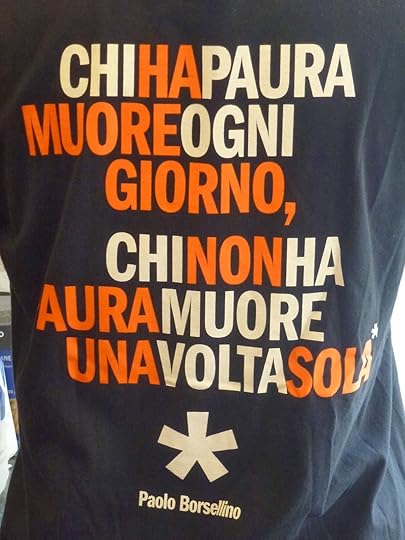 'A person who is afraid dies every day, someone who isn't only dies once.'
'A person who is afraid dies every day, someone who isn't only dies once.'
Published on December 05, 2013 05:31
October 21, 2013
Empires of the Sea en espanol!
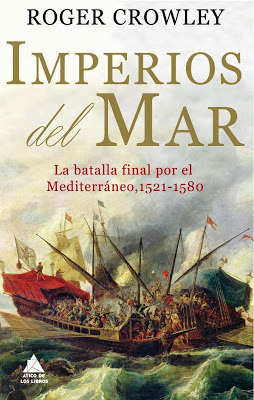 Much of Empires of the Sea is to do with the history of Spain - so it's really nice, and a little daunting, to see a Spanish version.
Much of Empires of the Sea is to do with the history of Spain - so it's really nice, and a little daunting, to see a Spanish version.
Published on October 21, 2013 05:20
October 20, 2013
Fill up the car while you get married?
This is the photo that caught my attention this week. A warm Greek night. The golden lights of the petrol station glowing in the dark. On the right, just visible, the illuminated suspension bridge that spans the gulf of Corinth, joining the Peloponnese to mainland Greece. And on the forecourt, between the manhole covers, people are dancing. The woman in white with her back to the camera is the bride. Welcome to a Greek austerity wedding.
There's something incredibly moving about this image. A sense of solidarity, of tradition, of the ability to celebrate in adversity. And Greek hospitality. The Belgian photographer passing by who took this picture was welcomed into the circle of light, plied with drinks and stayed until three in the morning.
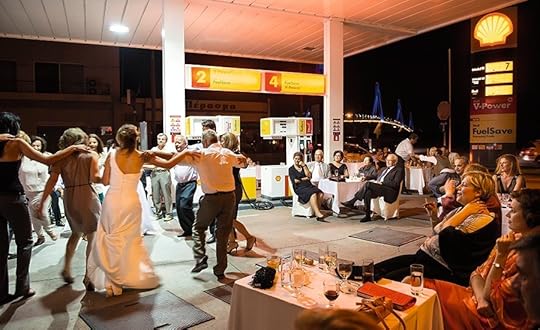
There's something incredibly moving about this image. A sense of solidarity, of tradition, of the ability to celebrate in adversity. And Greek hospitality. The Belgian photographer passing by who took this picture was welcomed into the circle of light, plied with drinks and stayed until three in the morning.

Published on October 20, 2013 00:13
October 11, 2013
Uncle Joe's holiday hide-away
As it happens I had no time to see Suleiman the Magnificent (see blog entry of 2 September), when I was in Istanbul – I was at the start of a fortnight’s lecturing on Zegrahm Expedition’s circumnavigation of the Black Sea – a great two-week trip round the coast of Turkey, Georgia, Russia, the Ukraine, Romania and Bulgaria. Instead of Suleiman’s tomb I got to see Stalin’s get-away from the toils of oppressing the Russian people: his dacha outside Sochi.
Set in fir woods on the airy hills above Russia’s ‘Mediterranean’ coast – it was a fascinating insight into the man – a mixture of domesticity and paranoia in equal measures. A long low series of buildings around a verdant courtyard, protected by four concentric rings of security and painted green for camouflage – Stalin was taking no chances.
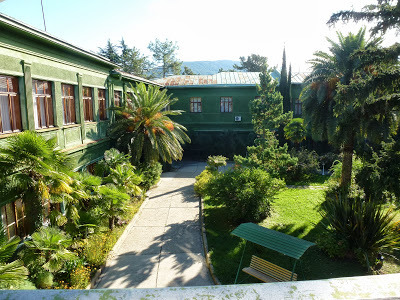
On the mountain above he ordered the erection of a tall look-out tower; in his working room he had a bizarre bullet proof sofa – the very last resort one would have thought and only of any use if being shot from behind – and concealed alcoves outside rooms for burly guards.
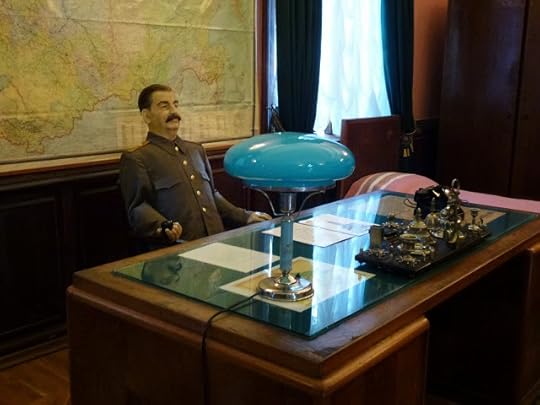 Stalin 'at the helm' in his work room. The telephone has no dialling features. It went straight through to just one destination - the Kremlin. His day bed is behind and is extremely short - he was tiny, only 5 foot 3.
Stalin 'at the helm' in his work room. The telephone has no dialling features. It went straight through to just one destination - the Kremlin. His day bed is behind and is extremely short - he was tiny, only 5 foot 3.And yet the place also felt deeply pleasant. Unpretentious but beautiful wooden walls and ceilings, spacious verandas looking out into the forest where Joe and his family would while away afternoons around the samovar, a billiard table and chess board – I wonder who won all the games – an indoor swimming pool. A sense of deep tranquillity in the Russian woods. When it all got too much the family man and epic mass murderer would come here for up to three months at a time. To forget.
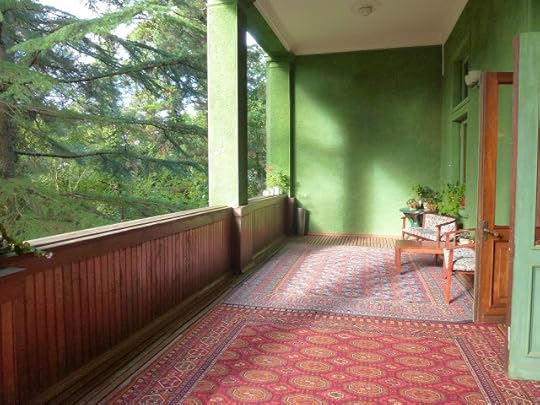
 The luxury pool
The luxury pool 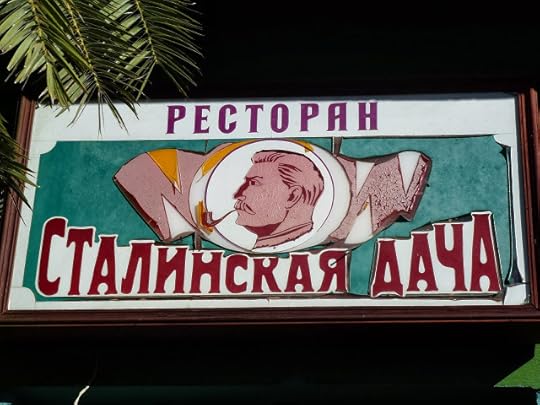 A meal in the ogre's lair?
A meal in the ogre's lair?The next day we went Yalta and stared at the huge round table where Stalin fooled Roosevelt and Churchill at the Yalta conference in 1945.
Published on October 11, 2013 13:18
September 28, 2013
The man who saved the world
The early hours of 12 September 1983. Stanislav Petrov, a civilian in a military system, is on duty monitoring the USSR’s nuclear war early-warning system. The computer registers an incoming US missile strike. The siren howls. His screen lights up and flashes the peremptory order ‘Launch it’. Petrov is under default order to press the button. He has to act. What should he do?
Published on September 28, 2013 02:03
September 2, 2013
Searching for the sultan's heart
In September 1566, Sultan Suleiman the Magnificent was bogged down before the walls of Szigetvar, an insignificant Hungarian fortress. He was seventy two years old. It was his eleventh campaign. Suleiman had spent years in the saddle, extending the reach of the Ottoman empire. He had shattered the Hungarian before, at Mohacs in 1526; the skulls of the defeated still whitened the plains, but the wars went on, were never ending. Frustrated by the resistance of this military pimple disturbing the projects of the 'The Shadow of God on Earth' he seemed to have become enveloped in gloom. His long and brilliant reign had been dogged by tragedy, revolt, disillusionment. The sultan had become reclusive, pious and grave. 'This chimney is still burning, and the great drum roll of conquest has yet to be heard', he wrote from his magnificently embroidered tent. A few hours later he was dead.
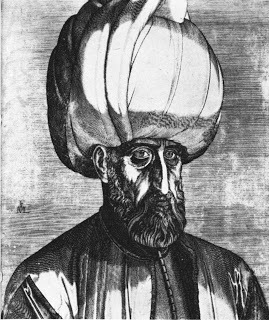 The elderly Suleiman, haggard with the cares of office.
The elderly Suleiman, haggard with the cares of office.
The body was embalmed secretly, packed into a chest and trundled back to Istanbul, whilst a body double, seated in his imperial carriage behind a curtain, preserved the illusion that he still lived - until the time was right to proclaim his successor and only surviving son - Selim. All the others had died or been executed for fear of insurrection.
His heart, though, was apparently buried at Szigetvar, which was totally destroyed in the final collapse of a heroic defence. And now a team of Hungarian researchers are looking for it.
The Ottomans are big in the modern Turkish imagination. A fantastically popular TV costume drama has ignited interest in the greatest sultan as Turkey seems to be propelling itself forward in a new era of Ottoman-inspired influence. They'd love the heart to be found. And the Hungarians would love to find it - fantastic for the tourist trade! Read the BBC story here.
I'm off to Istanbul on Wednesday to take part in a cruise round the Black Sea. Maybe I'll find time to tip my turban at the great man's tomb - even if he is lacking a heart, so to speak.
 The elderly Suleiman, haggard with the cares of office.
The elderly Suleiman, haggard with the cares of office.The body was embalmed secretly, packed into a chest and trundled back to Istanbul, whilst a body double, seated in his imperial carriage behind a curtain, preserved the illusion that he still lived - until the time was right to proclaim his successor and only surviving son - Selim. All the others had died or been executed for fear of insurrection.
His heart, though, was apparently buried at Szigetvar, which was totally destroyed in the final collapse of a heroic defence. And now a team of Hungarian researchers are looking for it.
The Ottomans are big in the modern Turkish imagination. A fantastically popular TV costume drama has ignited interest in the greatest sultan as Turkey seems to be propelling itself forward in a new era of Ottoman-inspired influence. They'd love the heart to be found. And the Hungarians would love to find it - fantastic for the tourist trade! Read the BBC story here.
I'm off to Istanbul on Wednesday to take part in a cruise round the Black Sea. Maybe I'll find time to tip my turban at the great man's tomb - even if he is lacking a heart, so to speak.
Published on September 02, 2013 08:45
August 16, 2013
The machine gun inventor who vanished
An absolutely fascinating story on the BBC website today. The mystery of William Cantelo. The sounds of rapid gunfire from the basement in a house in Southampton in the 1880s – an inventor called William Cantelo tells his sons that he has invented a new type of gun that will fire bullets in rapid succession. He packs it away and sets off – presumably to sell it. He vanishes into thin air.
A couple of decades later, another inventor, Sir William Maxim, is getting rich from an invention of his own – the Maxim gun, mowing down thousands of men in the First World War.
But Maxim and Cantelo look uncannily alike. And Cantelo’s sons put a private detective on the case. They spot ‘Maxim’ at Waterloo Station and shout "Father"…but the elusive figure gets away. And money disappears from Cantelo’s account after he vanishes. Maxim meanwhile has a reputation for ‘brain-sucking’ – stealing people’s ideas. Were Maxim and Cantelo the same man? Did Maxim somehow steal Cantelo’s invention? Who knows? A murky Victorian melodrama? Read it here.
Published on August 16, 2013 04:58
August 10, 2013
The Dark Lady comes to light
I admit to having a slightly nerdy interest in Shakespeare. We know so little about him. His personality, his biography, his relationships - these are almost a blank. Yet we think we know so much through the rich, complex, evocative worlds that are the plays. It's so tempting to make connections between the man and the work, as it is for any writer. The plays and their inhabitants are so vivid, yet, as Shakespeare suggests, they’re all just unstable illusions, magnificent cloud structures conjured out of words. They die when the players depart the stage, leaving the master puppeteer invisible in the darkness beyond.
So from the fragmentary information that we do have, I'm absolutely fascinated when someone is able to find new hard data about his life. In today’s Guardian Saul Frampton makes a hugely convincing case based upon linguistic analysis, close study of contemporary writers and scrutiny of English parish records for having identified the Dark Lady, one of the addressees of his sonnets (‘Shall I compare thee to a summer’s day’). It's a tale of sexual jealousy and literary revenge on Shakespeare by a man called John Florio that concerns his wife AD, Avis Danyell, baptised February 8 1556, died of the plague sometime around the end of the century. Absolutely fascinating. The wonder of dogged scholarship. If you're interested in the step by step process of patient deduction you can read it here.
That still leaves unresolved the equally fascinating issue of Shakespeare's relationship with a young man, Henry Wriothesley, and a possible love triangle...
So from the fragmentary information that we do have, I'm absolutely fascinated when someone is able to find new hard data about his life. In today’s Guardian Saul Frampton makes a hugely convincing case based upon linguistic analysis, close study of contemporary writers and scrutiny of English parish records for having identified the Dark Lady, one of the addressees of his sonnets (‘Shall I compare thee to a summer’s day’). It's a tale of sexual jealousy and literary revenge on Shakespeare by a man called John Florio that concerns his wife AD, Avis Danyell, baptised February 8 1556, died of the plague sometime around the end of the century. Absolutely fascinating. The wonder of dogged scholarship. If you're interested in the step by step process of patient deduction you can read it here.
That still leaves unresolved the equally fascinating issue of Shakespeare's relationship with a young man, Henry Wriothesley, and a possible love triangle...
Published on August 10, 2013 09:41
July 26, 2013
A face in the dark
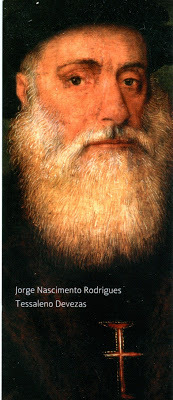 It’s been uniquely hot in England over the last few weeks – we wait a decade for a spell of good weather like this then I find myself spending much of my days in a cool darkish room in our three hundred year old stone cottage, writing. My companion on the desk has been this picture. It’s an image on a book mark for a book that I bought – hence the names of the authors visible on the section I’ve reproduced. I didn’t particularly choose to have it there but the desk tends to accumulate objects that take up residence – until it all gets too crowded and I shoo them off, but I like this face, and it’s survived the recent clearing back.
It’s been uniquely hot in England over the last few weeks – we wait a decade for a spell of good weather like this then I find myself spending much of my days in a cool darkish room in our three hundred year old stone cottage, writing. My companion on the desk has been this picture. It’s an image on a book mark for a book that I bought – hence the names of the authors visible on the section I’ve reproduced. I didn’t particularly choose to have it there but the desk tends to accumulate objects that take up residence – until it all gets too crowded and I shoo them off, but I like this face, and it’s survived the recent clearing back.It’s a portrait of Vasco da Gama, painted at the very end of his life. I’ve seen the original in a museum in Lisbon, which is surprisingly small. It’s an exquisite image. The face glows against the dark background; a gentle, almost serene expression, the beard caught by a soft radiance. The gold cross gleaming out of the blackness is that of the Order of Christ, Portugal’s crusading order, the successor to the Templars who uniquely escaped persecution in the country by a crafty piece of rebranding just as they were being wiped out.
It seems to me the face of a man who has lived his life and come to terms with everything. The cross is evidently there as an emblem of his faith and deeds as a crusader for Christ. I have to say the meekness of the face rather clashes with the known facts. Da Gama enjoys a terrible reputation as the conquistador of the Indian Ocean, guilty of some awful atrocities, possessed of a violent temper and not in the least tranquil. Maybe in old age serenity came upon him; maybe he was flattered in the painting. Whatever, he gazes calmly up at me. The days are hot. Outside the bees rummage the flowers. I write on.
Published on July 26, 2013 03:21
Roger Crowley's Blog
- Roger Crowley's profile
- 820 followers
Roger Crowley isn't a Goodreads Author
(yet),
but they
do have a blog,
so here are some recent posts imported from
their feed.



